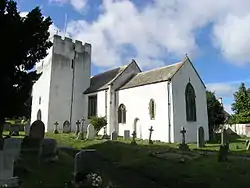Withycombe
Withycombe is a village, civil parish, and former manor 2.5 miles (4 km) south east of Dunster, and 5 miles (8 km) from Minehead within the Exmoor National Park in the Somerset West and Taunton district of Somerset, England. The parish includes the village of Rodhuish. The manor house of the manor of Withycombe survives as Sandhill Farm.[2]
| Withycombe | |
|---|---|
 | |
 Withycombe Location within Somerset | |
| Population | 293 (2011)[1] |
| OS grid reference | SS825385 |
| District | |
| Shire county | |
| Region | |
| Country | England |
| Sovereign state | United Kingdom |
| Post town | Minehead |
| Postcode district | TA24 |
| Police | Avon and Somerset |
| Fire | Devon and Somerset |
| Ambulance | South Western |
| UK Parliament | |
History
The Domesday Book of 1086 lists Withycombe as one of the possessions of Geoffrey de Montbray, Bishop of Coutances, whose tenant there was Edmer. His heir was Robert Mowbray, who forfeited his estates to the crown for rebelling against William II, who regranted many of the Somerset estates to the Mohun family, henceforth feudal barons of Dunster.[3]
The manor of Withycombe was centred on the village. In about 1212 the manor was split into two separate sub-manors, which took various names over time, dependent on the family name of their lords.[3] By the 16th century the names of the two manors were "Withycombe Wyke" (or Weeke, etc.) and "Withycombe Hadley". The former manor house of Withycombe Hadley survives as Court Place in the village of Withycombe.
The Hadley family inherited the manor of Withycombe by marriage to the heiress of the Durborough family.[3] The manor passed to the Lutterell family when Margaret Hadley married Thomas Luttrell in 1560.[4] At some time before 1777 John Fownes Luttrell acquired the other sub-manor of Withycombe Weke,[3] and thus the manor of Withycombe was unified to its pre-1212 position.
On Rodhuish Common, within the parish, is a univallate Iron Age hill fort.[5]
Withycombe was part of the hundred of Carhampton.[6]
Governance
The parish council has responsibility for local issues, including setting an annual precept (local rate) to cover the council's operating costs and producing annual accounts for public scrutiny. The parish council evaluates local planning applications and works with the local police, district council officers, and neighbourhood watch groups on matters of crime, security, and traffic. The parish council's role also includes initiating projects for the maintenance and repair of parish facilities, as well as consulting with the district council on the maintenance, repair, and improvement of highways, drainage, footpaths, public transport, and street cleaning. Conservation matters (including trees and listed buildings) and environmental issues are also the responsibility of the council.
The village falls within the non-metropolitan district of Somerset West and Taunton, which was established on 1 April 2019. It was previously in the district of West Somerset, which was formed on 1 April 1974 under the Local Government Act 1972, and part of Williton Rural District before that.[7] The district council is responsible for local planning and building control, local roads, council housing, environmental health, markets and fairs, refuse collection and recycling, cemeteries and crematoria, leisure services, parks, and tourism.
Somerset County Council is responsible for running the largest and most expensive local services such as education, social services, libraries, main roads, public transport, policing and fire services, trading standards, waste disposal and strategic planning.
It is also part of the Bridgwater and West Somerset constituency county constituency represented in the House of Commons of the Parliament of the United Kingdom. It elects one Member of Parliament (MP) by the first past the post system of election.
Religious sites
The Church of St Nicholas dates from the 13th century and has been designated by English Heritage as a grade I listed building.[8] Hidden in a wall recess is a figure of an unknown man with long hair and a hat, which is one of the earliest church monuments to include a hat. He is carrying a heartcase to show he died elsewhere and only his heart was brought to the church for burial.[9]
The Church of St Bartholomew, Rodhuish was built in the 15th century. It is a Grade II* listed building.[10]
References
- "Statistics for Wards, LSOAs and Parishes — SUMMARY Profiles" (Excel). Somerset Intelligence. Retrieved 4 January 2014.
- "Sandhill Farmhouse and Walls Enclosing Forecourt on South Front with Mounting Block Attached". Historic England.
- Victoria County History, Withycombe Manors and Estates
- Jim Lee (11 November 2016). The Ladies of Dunster Castle. Mereo Books. pp. 131–132. ISBN 9781861516961.
- Historic England. "Rodhuish Common (1139717)". Research records (formerly PastScape). Retrieved 26 March 2011.
- "Carhampton Hundred". Domesday Map. Archived from the original on 8 October 2012. Retrieved 23 September 2011.
- "Williton RD". A vision of Britain Through Time. University of Portsmouth. Retrieved 5 January 2014.
- Historic England. "Church of St Nicholas (1057311)". National Heritage List for England. Retrieved 2 February 2008.
- Leete-Hodge, Lornie (1985). Curiosities of Somerset. Bodmin: Bossiney Books. pp. 55–57. ISBN 0-906456-98-3.
- Historic England. "Church of St Bartholomew (1175299)". National Heritage List for England. Retrieved 4 September 2017.
External links
![]() Media related to Withycombe at Wikimedia Commons
Media related to Withycombe at Wikimedia Commons
